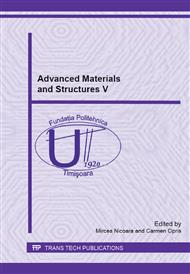[1]
P. Peyre, C. Braham, J. Ledion, L. Berthe, R. Fabbro, Corrosion Reactivity of Laser-Peened Steel Surfaces, ASM International, JMEPEG (2000) 9: 656–662.
DOI: 10.1361/105994900770345520
Google Scholar
[2]
J.Z. Lu, K.Y. Luo, D.K. Yang, X.N. Cheng, J.L. Hu, F.Z. Dai, H. Qi, L. Zhang, J.S. Zhong, Q.W. Wang, Y.K. Zhang, Effects of laser peening on stress corrosion cracking (SCC) of ANSI 304 austenitic stainless steel, Corrosion Science, (2012) 145-152.
DOI: 10.1016/j.corsci.2012.03.044
Google Scholar
[3]
L. Hyuntaeck, K. Pilkyu, J. Hoemin, J. Sungho, Enhancement of abrasion and corrosion resistance of duplex stainless steel by laser shock peening, Journal of Materials Processing Technology 212-6 (2012) 1347– 1354.
DOI: 10.1016/j.jmatprotec.2012.01.023
Google Scholar
[4]
P. Peyre, C. Carboni, P. Forget, G. Beranger, C. Lemaitre, D. Stuart, Influence of thermal and mechanical surface modifications induced by laser shock processing on the initiation of corrosion pits in 316L stainless steel, J. Mater. Sci., (2007).
DOI: 10.1007/s10853-007-1502-4
Google Scholar
[5]
P. Peyre, X. Scherpereel, L. Berthe, C. Carboni, R. Fabbro, G. Beranger, C. Lemaitre, Surface modifications induced in 316L steel by laser peening and shot-peening. Influence on pitting corrosion resistance, Materials Science and Engineering, A280, (2000).
DOI: 10.1016/s0921-5093(99)00698-x
Google Scholar
[6]
U.I. Thomann, P.J. Uggowitzer, Wear–corrosion behavior of biocompatible austenitic stainless steels, Wear, 239, (2000) 48–58.
DOI: 10.1016/s0043-1648(99)00372-5
Google Scholar
[7]
U. Trdan, J.L. Ocaña, J. Grum, Surface Modification of Aluminium Alloys with Laser Shock Processing, Journal of Mechanical Engineering, 57, (2011)5 385-393.
Google Scholar
[8]
I.B. Roman, M.H. Tierean, J.L. Ocaña, Effects of laser shock processing on 316L stainless steel welds, Journal of Optoelectronics and Advanced Materials, Vol. 15, No. 1- 2, (2013) 121–124.
Google Scholar
[9]
I.B. Roman, M.H. Tierean, J. L, Ocaña, C. Munteanu, Microstructural characterization and friction coefficient after the laser shock processing treatment on AISI 316 L stainless steel welds, Journal of Optoelectronics and Advanced Materials, Vol. 15, No. 7- 8, (2013).
Google Scholar
[10]
http: /www2. mtec. or. th/th/research/famd/corro/electrochem. html#Review of the Electrochemical Basis of Corrosion.
Google Scholar
[11]
http: /metals. about. com/od/Corrosion/a/Corrosion-Rate-Calculator. htm.
Google Scholar


